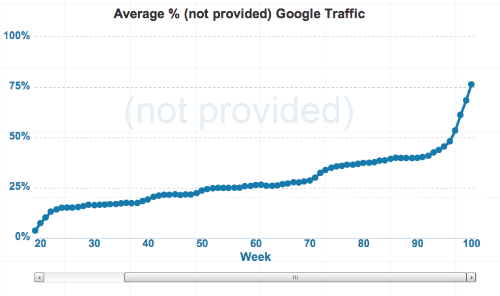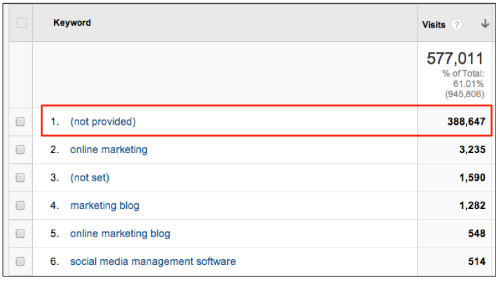
Something is missing! Can we fix it?
We started this week off with a bang – at least in the search world, with Google now redirecting all traffic to https, i.e. encrypted search.
What that means is, if you were wondering what keyword phrases people use on Google organic search to find your website, you’re out of luck. While keywords are an important answer to the relevance of your website to buyers, now those answers are simply listed as (not provided).
Google has been masking keyword data for logged in users for about 2 years, so dealing with omitted keyword data is nothing new to agencies like yours truly at TopRank Online Marketing.
We’ve been consulting with clients on a variety of ways to extract keyword insight from ranked web pages, treating historical and limited keyword data as a sample and using alternative feedback in order to optimize search marketing performance. But this recent change closed the door on the direct line of sight from organic query to conversion.
I admit the shift from 50% to 75% and soon 100% of (not provided) keywords has been a bit frustrating and inspired a number of blog post ideas like:
- 100% of Companies World Wide Lose Keyword Insights from Google
- Google Betrays Agreement With Web Site Owners to Trade Copies of Our Websites for Keyword Data
- Get Over (not provided) Now’s the Time to Upgrade Your Online Marketing & Optimize for Customers
- What? You’re Still Relying on Inaccurate Keyword Data From Google?
- How to UnGoogle Your Online Marketing
Actually, only one of these is real and in the queue. Can you guess which?
Here’s the thing: Google handles about 67% of all search engine queries every month according to comScore’s August 2013 Search Engines Ranking report. Billions of searches from billions of users gives Google a lot of power. But why make this change?
On Search Engine Land, Danny Sullivan says the move to 100% encrypted search is to provide protections for searchers. He also suggests the change is a means to block NSA spying activity. Or maybe it was done to boost AdWords advertising sales? That makes sense, since without feedback from organic search referring keywords, it’s near impossible to know specifically which phrases drove visitors and buyers to pages on your website. Of course Google discounts that reason, “The motivation here is not to drive the ads side — it’s for our search users”.
As I mentioned above, website owners and marketers have been dealing with a partial “not provided” situation for the past 2 years where secure search was initiated for any user of a Google service, whether logged into Gmail, Google Analytics, YouTube, Google Adwords or other Google service.

But that number has been going up and up until this week where it’s pretty much at 75% and soon to be 100%. You can see a clever graph of this trend on Not Provided Count.
At first glance this looks like a major omission of critical data not only for SEO specialists but for content, social media and any online marketer at companies who rely on search and the optimization of search performance to attract audiences to their content.

You can see from the Google Analytics organic search query report above, the vast majority of referring keywords used by people to find this site on Google are (not provided).
Refining content planning to better serve readers with the topics they’re most interested in will not be supported through search analytics any longer. At least not in the same way.
What is Organic Keyword Data Good For?
Of course keyword data is incredibly useful for benchmarking performance of content within search and can be an important signal for content planning topics, social media messaging and subsequent optimization. For tier one optimization pros, all of these efforts are designed to improve both user experience and marketing performance. As I like to say, the best SEO is invisible to the reader.
Not Provided is Not New
The reality of dealing with (not provided) organic keywords is that various workarounds have been in place since late 2011. Many strategies focus away from keywords to page level performance. Mapping keywords to content and then optimizing it followed by monitoring ongoing organic search traffic to those pages provides some basic level of insight. Other solutions for assessing organic keyword impact on your web site involve using:
- Google Webmaster Tools
- Search Ranking Reports
- AdWords Keyword Data
- Organic & Paid Report in AdWords
- Data from Other Search Engines like Bing
SEOs Feeling Betrayed
For many SEOs, this sort of change might feel like a betrayal of the symbiotic relationship Google has had with website owners where Google makes copies of website content and then organizes it into search results so they can then run ads next to it. In return, Google provides various services and access to data for free – like organic search keywords data. Not any more.
What does missing organic keyword data (not provided) mean for online marketers?
Keyword data within web analytics serves multiple purposes including measuring the performance of content at driving awareness, engagement and transactions, as well as an indicator of what topics work and uncovering new topics.
But unless you’re advertising with Google’s AdWord program, that insight is gone. Google is still copying our sites though, which is something site owners can stop, but who in their right mind would do that? Google drives hundreds of millions of visitors to websites world wide and excluding the opportunity to attract organic traffic, even if it’s now a bit of a mystery as to what was searched on, would be foolish.
Impacts for All Marketers:
1. Lack of keyword specific traffic
2. Can’t track specific keyword trends over time, by seasonality, by geography
3. Inability to iteratively optimize based on user intent
4. Can’t determine the brand vs. non-brand keyword mix over time which reflects impact of other media driving search (ads, owned, earned, shared)
Alternatives for marketers: Correlate keyword content mapping and ranking of a page to the traffic of the page – From a keyword glossary you map which keywords are most relevant for corresponding, optimized web pages. Then look at the relative ranking of keywords and pages as well as organic referred search traffic to those pages. Line up the page metrics and you can get a rough idea of the search performance according to keywords based on the assumption that pages optimized for certain phrases that also rank high and get high traffic are due to the attraction of the designated phrases.
Impact for Content Marketers:
Organic keyword referrals serve as a great content ideation tool for surfacing trending topics of interest to your target audience. Search is an instrumental tool for attracting interested buyers across the entire buying and customer lifecycle. One of the tactics we’ve had great success with is to mine organic keyword data for questions (how, what, why + the use of ?) to literally identify questions users are typing into the Google search box. Answering these questions can be some of the best content on your website.
Alternatives for content marketers:
Paid search referrers will still be available assuming you are running PPC ads. Keyword research tools like Ubersuggest are still quite useful for identifying questions and syntax of questions being asked via search queries. Just not for your site specifically. Queries that occur on your site’s internal search engine will also continue to provide insight into topics and phrase syntax of what buyers are currently most interested in. Along with social media monitoring, those data sources can continue to provide rich insights for topic ideation.
Impact for Social Media Marketers:
Many types of media drive people to search Google including social media. When optimizing social media messages, search keyword glossaries are often used to guide social content messaging. Optimizing a Tweet may not seem a worthwhile investment, but the message within the tweet itself can drive people to search on the topic on Google to find more information – like that information offered by your company. Marketers that want to tap into the keywords that are already driving traffic and inquiries to a site will not be able to do so as a result of not provided.
Alternatives for social media marketers:
Optimizing social content for secondary search queries is already a bit fuzzy to measure. Tracking the value comes from overall increases in the number of queries used in social messaging. Keyword research tools do include popularity scores as a reflection of demand. Ideation of keywords for use in social messages is still solid. Measuring their impact on an increase in search queries might be replaced by looking at an increase in the use of the phrase overall – in updates, comments and messages. A “social share of voice” for a keyword, so to speak.
There are a litany of articles about how to hack your way into the state of mind that you can actually get organic keyword data back by correlating, extrapolating and various types of number crunching. Here are a few:
- Smarter Data Analysis of Google’s https (not provided) change: 5 Steps – Avinash Kaushik, Occam’s Razor
- How to measure branded search traffic in the ‘Not Provided’ age – Chris Lake, Econsultancy
- Four More Ways to Crack the Keyword (not provided) Code – Sean Ellis, KISSmetrics
- How To Turn (Not Provided) Into Useful, Actionable Data – Carrie Hill, Search Engine Land
There are also some Google Analytics plug-ins like those offered at Dan Barker’s Not Provided Toolkit and find lots more custom GA reports here. Dan’s plug-ins will segment data so you can easily see the following info:
- Your current percentage of not provided organic search referrers
- Full Dashboard including graphs, metrics and breakdowns by browser and device
- Detailed report showing full landing page info
- Not provided segment – any GA report including NP data
- Keyword known segment where only google keyword data is present
- Not Google segment – only data where keyword data is present from other search engines
Google is now offering the Organic and Paid Report in AdWords that could prove to be useful as could Google Webmaster Tools which offers the top 2,000 terms per day going back 90 days. Another angle is to use Landing Page Analysis with GA or AdWords Keyword Data. Data from Bing is still 100% provided, except Bing has a much smaller portion of search market share.
Interestingly, there’s an opportunistic tool from Conductor called TrueTraffic: that makes some interesting promises: “…calculates the traffic and revenue generated by individual keywords based on their online visibility, and consumer demand and behavioral models.”
The bottom line is that you can still do keyword research to anticipate demand for phrases that reflect what your customers care about. It’s also true that you can still use those keyword insights to optimize titles, body copy, links and digital assets to improve the relevance and findability of content through search.
In fact, just because your organic keywords are now (not provided) in analytics reports, don’t even think about stopping your SEO best practices. They still work. How do you know? You’ll just have to be more patient and creative about connecting those dots. It’s that creative and adaptable thinking that I appreciate most about the SEO industry.’
Going Forward With Not Provided:
Content Marketers can continue to rely on keyword research tools for topic inspiration and leverage topic to page mapping to identify clusters of pages and their associated consumption / action metrics to gauge content performance. Paid Search ads are still an option too, since those keywords are (still provided). Ranking reports and Google Webmaster Tools can provide a relative measure for keyword visibility.
Most importantly, planning content based on the customer journey and creating content experiences that drive business outcomes is still the main focus with content marketing. Keyword optimization supports the amplification of content, but there are many ways to amplify in addition to search.
Social Media Marketers can continue to leverage social media monitoring and keyword research tools for topic ideation. The use of target keyword phrases in social messages to drive increased search might not be as measurable through organic keyword referrals, but an increase in keyword usage on social platforms can serve as a sort of “social media share of voice” tracked with social media monitoring tools. The correlation between social messaging and topics with business outcomes is as relevant as ever.
SEOs can basically kiss their asses good bye. Ha ha, just kidding! I think SEOs will diversify their skill sets even more and learn how other disciplines are measuring topic based performance. Without expanding skill sets in content, social media and PR a lot of SEOs will be hard pressed to create impact. At the same time, I think SEOs will develop all-new ways of enabling keyword and page level optimization that we haven’t even thought of yet. Lack of direct line of sight keyword data does not limit SEO best practices nor does it stop brand content from becoming easy to find where buyers are actively looking.
Photo source: Shutterstock


